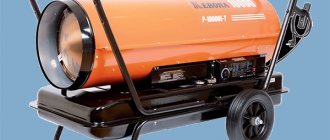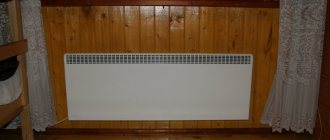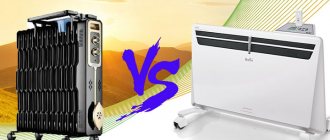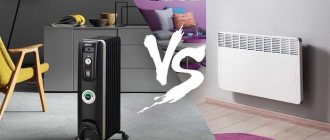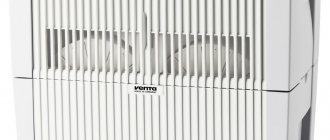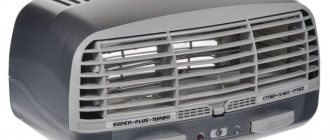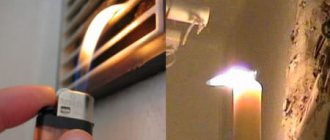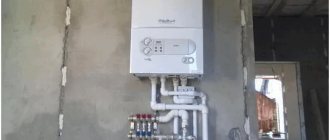In the off-season, when it is already cold and damp, sales of electric heaters increase sharply. The most popular types of appliances are convectors and fan heaters. They are inexpensive, compact, perfectly heat rooms and are in approximately the same demand.
And yet there is a significant difference between them. Let's figure out what is better - a convector or a fan heater for heating a house.
- Brief overview of the best brands
The type of heater matters
Fan heaters and convectors are often purchased for apartments in high-rise buildings, but sometimes they are also needed in houses. In an apartment, the heater serves as the main heating system in cold weather, and in a private house the owner can use it as an additional and/or alternative heating system.
The devices are also installed in rooms that require special temperature conditions (children's rooms, bathrooms, etc.).
Fan heaters are ideal if you need to quickly warm up the air. They are indispensable in the cold season at dachas, garages, workshops, etc. Convectors require more time, but their operation is more stable and energy consumption for heating is less
The basis for a meaningful choice of any device is an understanding of the principle of its operation, design, disadvantages and advantages. There is no ideal and universal technology, so you need to figure out which models are best suited for specific operating conditions. You should also decide on your own needs, priorities and expectations.
Useful tips
Models with a ceramic heating element are more expensive. But they perform much better in operation.
In the store, look at the back panel of the device. If you see a sponge filter for coarse cleaning, then know that the air in the room will be much cleaner.
The optimal power of the device is from 1 to 3 kW. In order for the device to be easy and convenient to use, the power must be adjusted smoothly.
Read more: Rating of the TOP 7 best Samsung washing machines!
It makes sense to buy devices that have a well-thought-out security system. It should provide protection against overheating and will automatically turn off the device if it is suddenly knocked over.
A fan heater should be used to dry cottages after winter or in small rooms with drafts. The device is convenient when there is a need to warm up the room frequently and quickly.
Enterprises produce models of various types - gas, electric, water. However, practice has shown that electric convectors are more often on sale. These are the ones that Russian buyers prefer.
Gas or water models are also in demand. They are bought by those who have a house or dacha outside the city. These devices are less suitable for an apartment.
When choosing a device, pay attention to products under the brand of well-known manufacturers. It makes sense to choose a model with an electronic thermostat. After all, it will control temperature changes. Moreover, with an accuracy of 1 degree.
Electric convectors are very good for a small room with low or standard ceilings. When the ceiling height exceeds three meters, a fan heater is better. Better yet, several fan heaters. Then they will quickly warm the air and mix it. And as a result, strong cooling will not occur.
Convectors with a power from 0.25 to 2.5 kWe are good for home use. The power depends on the area of the room. There is a reason to find out in the store the heating temperature of the case. Let's say, to work in a children's room, the case needs to heat up to 55 degrees.
Advantages and disadvantages of fan heaters
Fan heaters are inexpensive and efficient devices that are purchased for heating residential, administrative, and industrial premises. By choosing the right model, you can create a warm zone within a few minutes. To do this, you just need to point the fan heater in the desired direction and turn it on.
This is an excellent choice if you need to quickly warm the air in a separate area of the room. Such fan heaters are installed next to beds and work tables. They are also used if you urgently need to finish drying washed items.
Large stationary models are installed on the floor or mounted on walls, while mobile ones are easy to carry, rotate, and move to another location. The housings of the devices do not overheat, so there are no special requirements for surfaces. Fan heaters are placed on any floor coverings, tables, cabinets.
An ideal option for heating a living space or office during the off-season. The model can be installed so that it creates a thermal curtain at the entrance to the room or at the window
The principle of operation is simple: cold air enters a closed or open heating element, instantly warms up, and the fan throws it out. The result is the effect of a warm wind that blows across people and objects in the room. Heated air flows are mixed with cold ones, thanks to which a comfortable temperature is quickly established in the room.
Hot air moves forward - in the direction where the device is pointed, and then rises. The distance that the heat flow travels depends on the power and design features of the model
When choosing, they focus not only on the desired power and noise level, but also on the type of heating element. Depending on it, the following fan heaters are distinguished:
- Spiral . The heaters are made of spiral nichrome wire. In working condition, their temperature can reach 800°C. Despite their high efficiency, these heaters are considered not the best choice, because... During operation they burn dust and moisture. As a result, the air becomes dry and an unpleasant odor appears.
- Heating elements. The temperature of the heating element does not exceed 200°C, but this does not affect the quality of work due to its large area. The models are fireproof, convenient, but more expensive than spiral models.
- Ceramic . The elements heat up much less - up to 200°C, and do not burn out the air. They are absolutely safe and easy to use. This is the best choice for today. If you buy a model from a reliable brand, it will serve for a long time and without failure.
The advantages of fan heaters include compactness and high air heating speed. Almost all models are equipped with control panels for operating modes, temperature sensors, and some also have remote controls.
In some cases, uneven heating is a plus. If some area in the room needs more intense heating than others, you should choose a fan heater
Fan heaters also have disadvantages: noise during operation and uneven heating of the room. As for noise, it is impossible to completely solve this problem. The rotating fan blades will make sounds in any case. The noise may be greater or less, but it will always be there. You'll have to come to terms with this.
Brief overview of the best brands
In the rankings of the best manufacturers of fan heaters, the leaders are the same companies that produce the most reliable convectors: Ballu, Timberk, Vitek, Electrolux, Saturn, Polaris, AEG, NeoClima, Scarlett, Teplomash and others.
Image gallery
Photo from
Ballu and Timberk spiral fan heaters are considered the best in terms of price-quality ratio. These are reliable and easy-to-use devices that contain nothing superfluous. The only negative is that some models do not provide the ability to operate in regular fan mode
The range of Electrolux brand fan heaters is varied, but buyers pay special attention to wall-mounted units. They differ from analogues of other brands in their original design, compactness and ease of installation. The models are universal, suitable for installation in premises of any purpose, but sometimes you have to extend the cord, because... it's too short
If you are looking for a trouble-free floor fan heater, take a closer look at models from the Vitek and AEG brands. They are compact, efficient, nice looking and have many additional features that make them easier to manage. Some models can swivel, and all turn off when tipped over. Great option for home or office
Not many manufacturers produce fan heaters with heating elements. Among them, the Teplomash trademark deserves special attention. The models can hardly be called attractive, but they are excellent for heating spacious private houses and industrial premises. An additional advantage is that it can be used as a full-fledged powerful fan.
Ballu - inexpensive spiral models
Electrolux - the best wall-mounted models
Vitek – reliable floor fan heaters
"Teplomash" - the best heating element fan heaters
When choosing a fan heater or convector, it is worth considering that many of them are assembled in China. It is better to pay attention to manufacturers who strictly control product quality and buy models from those brands that have well-organized service centers.
Pros of a fan heater
- The speed with which it warms the room, if you choose the right power, the room can be heated in a matter of minutes. - The device is mobile, compact, economical. - There is a mode for maintaining the required temperature. - Low prices. - Attractive appearance. - Can be built-in to any interior. - There are additional functions.
Please note that when choosing a convector or fan heater, it is important to consider that there are several installation options in this category. These are wall-mounted devices that are designed in the style of an air conditioner. There are also floor and tabletop devices.
Most models can be rotated along a vertical axis and thereby evenly heat the entire room.
- Durability. The devices work for years.- The air heats up very quickly.- Works without creating noise.- Significant operating time.- It is possible to combine the device and the heating system.- Safety of use.- There are built-in thermostats. Thanks to them, you can set the temperature in the room that is necessary. - The dimensions are small. - Interesting design. - Sufficient fire resistance. - There is protection against tipping over.
IMPORTANT! Installation options are varied. Floor-standing ones are more mobile because they are equipped with wheels. Fastening elements have been developed for wall mounting.
It is difficult to understand what is the difference between a fan heater and a convector because, in essence, they simply circulate warm air. The principle of operation is as follows: warm air flows rise upward, and cold air flows fall down. But there are still differences. The fan heater is easy to operate and most buyers can afford it. Such units are:
- Tabletop;
- Floor-standing;
- “Thermal curtains” are installed under the door;
- Ceiling mounted.
Read more: Painting a cast iron bathtub - means and methods of restoration
Operating principle: a fan drives air through a heating element, from where it comes out warm. Note that the heating element can be:
- electrical;
- ceramic;
- tubular.
Buyers mainly make their choice in favor of fan heaters with a ceramic heating element, because the room is heated without any combustion products.
When heating a room with this electric heater, cold air passes through the grille, which is located at the bottom of the convector, and then through the heating element. As a result, warm air comes out through the grille on the top panel and is distributed throughout the room. Most models boast moisture resistance, so they can be used in saunas and bathrooms. Convectors are:
- Gas - expensive due to the need to connect to the gas main;
- Electric - the simplest and most common;
- Water;
- Infrared.
When comparing a convector and a fan heater, it becomes clear that the first is much more complex in design. By type of arrangement, convectors are:
- Floor-standing;
- Wall-mounted;
- Combined;
- In-floor.
What type of heating device is better to choose?
It all depends on the goals of the owner of the premises. If you need to achieve uniform heating of the entire area, and speed is not important, then it is better to install a convector. If the main goal is to obtain a directed flow of hot air and instant heating of a specific area in the room, a fan heater would be the best choice.
You can easily install a fan heater in your home office or office. The measured hum of the blades will not interfere, but will only help you concentrate, cutting off external sound stimuli
In residential premises, convectors are often installed due to the lack of noise, and for an office, where there is always some sound, a fan heater is appropriate.
Design and principle of operation of convectors
A microclimate that is favorable for a person in a room will be created when he takes care of a comfortable temperature and sufficient air humidity. In the case when the central heating is turned off, and also when it lacks power, the apartment becomes damp and cold.
An electric convector can cope well with this problem. It is assigned the functions of a heater. It will not allow excess moisture and will not dry out the air.
If you need to decide which is better - a convector or a fan heater, then the first thing you need to understand is that a convector is more complex in design than a fan heater. Its operation is based on the principle that air passing through a heated heat exchanger is heated due to natural or forced circulation of flows.
Read more: Retractable sockets for countertops: how and where best to install them
The operating principle of the heater is based on heat transfer using convection. In order for cold air to be drawn in, there are holes in the lower part of the housing. The flow passes through the heater. The air is heated and distributed throughout the room. This circulation continues as long as the convector is running.
IMPORTANT! Please note that cold air enters the convector through the grille, which is located at the bottom of the device. And the air comes out of the upper grill of the device. At the same time, it is evenly distributed throughout the room.
- Electric. They are very simple, and therefore have become widespread. To work, they only need to have voltage in the network. - Gas. These devices are more economical compared to electric ones. However, purchasing them will cost the user more. In addition, they will require connection to the gas main.
- Floor-standing. To make them easy to move, the devices have wheels. - Wall-mounted. They are placed a few centimeters from the floor. This provides better heating of the room. - Combined. - In-floor.
IMPORTANT! Please note that a convector is often used when it is necessary to dry the bathroom and other rooms with high humidity. If you need a device for this purpose, then pay attention to what the electrical protection class of the device is. It will be good if this is second grade. And the moisture protection class must be at least IP24.
